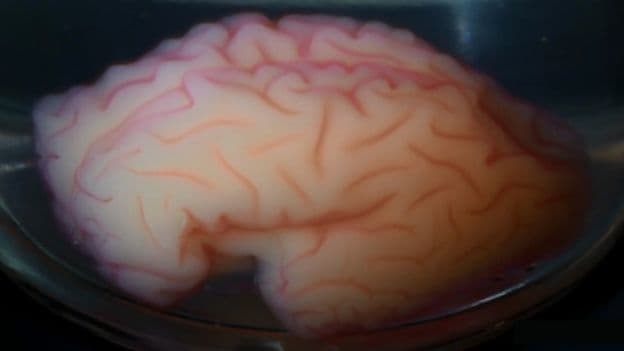Harvard Scientists Determine How The Human Brain Folds By 3D Printing It
Scientists from Harvard University, in collaboration with researchers from France and Finland, have used a 3D gel model of the brain to understand and explain how the brain forms its characteristic “foldsâ€. The research produced more obvious results than expected, as it was determined that the folds were formed due to simple mechanical forces, created by the brain’s growth.
Scientists have been studying the human brain for a long time, but they do get surprised every now and then. Understanding the organ which is a mini cosmos unto itself could be the key to preventing or treating the human world's brain-related diseases and neural damage.
As to why the brain shows folding, scientists agree that it is an evolutionary trait that allows accommodating a large amount of brain-matter in a small volume. Presence of excessive folding is generally related to having greater intelligence, as increased folding means a bigger brain, and hence, intellectual capacity. It was discovered that Albert Einstein, considered by many to be the most intelligent man to have ever lived, was born with a condition that caused his brain to develop a more-than-normal amount of folds, leading to his greater intelligence.
Even though the function of the folds of the brain have been explained, scientists have always been puzzled as to how the brain folds. A lot of theories have been put forward over time, and the experiment at Harvard was conducted to provide a conclusive answer.

The research team used a 3D gel model of a smooth fetal brain, constructed using MRI scans. The outer layer of the model brain was covered in a thin layer of elastomer gel, to mimic the grey matter of the brain. The brain was then immersed in a liquid solvent, which was absorbed by the outer gel layer. This caused the model to swell proportional to depth of different regions. The result was the formation of folds similar in shape and size to that of a real human brain.
From this experiment, the team concluded that the folds in the brain were caused by the mechanical elements coming in to play when the outer grey matter of the brain grows more in comparison to the underlying white matter. The difference in growth creates mechanical instability, which leads to the brain’s buckling.
Although the team was initially surprised at the resemblance of the model to a real brain, they are now trying to make the most of it. The similarity could provide a way to emulate the structure of a real brain accurately, and even predict how a young brain might develop with time.
Source: <a href="https://news.harvard.edu/gazette/story/2016/02/how-not-why-the-human-brain-folds/" target="_blank" rel="nofollow noopener noreferrer">How, not why, the human brain folds – Harvard Gazette</a>
Scientists have been studying the human brain for a long time, but they do get surprised every now and then. Understanding the organ which is a mini cosmos unto itself could be the key to preventing or treating the human world's brain-related diseases and neural damage.
As to why the brain shows folding, scientists agree that it is an evolutionary trait that allows accommodating a large amount of brain-matter in a small volume. Presence of excessive folding is generally related to having greater intelligence, as increased folding means a bigger brain, and hence, intellectual capacity. It was discovered that Albert Einstein, considered by many to be the most intelligent man to have ever lived, was born with a condition that caused his brain to develop a more-than-normal amount of folds, leading to his greater intelligence.
Even though the function of the folds of the brain have been explained, scientists have always been puzzled as to how the brain folds. A lot of theories have been put forward over time, and the experiment at Harvard was conducted to provide a conclusive answer.

The research team used a 3D gel model of a smooth fetal brain, constructed using MRI scans. The outer layer of the model brain was covered in a thin layer of elastomer gel, to mimic the grey matter of the brain. The brain was then immersed in a liquid solvent, which was absorbed by the outer gel layer. This caused the model to swell proportional to depth of different regions. The result was the formation of folds similar in shape and size to that of a real human brain.
From this experiment, the team concluded that the folds in the brain were caused by the mechanical elements coming in to play when the outer grey matter of the brain grows more in comparison to the underlying white matter. The difference in growth creates mechanical instability, which leads to the brain’s buckling.
Although the team was initially surprised at the resemblance of the model to a real brain, they are now trying to make the most of it. The similarity could provide a way to emulate the structure of a real brain accurately, and even predict how a young brain might develop with time.
Source: <a href="https://news.harvard.edu/gazette/story/2016/02/how-not-why-the-human-brain-folds/" target="_blank" rel="nofollow noopener noreferrer">How, not why, the human brain folds – Harvard Gazette</a>
0
